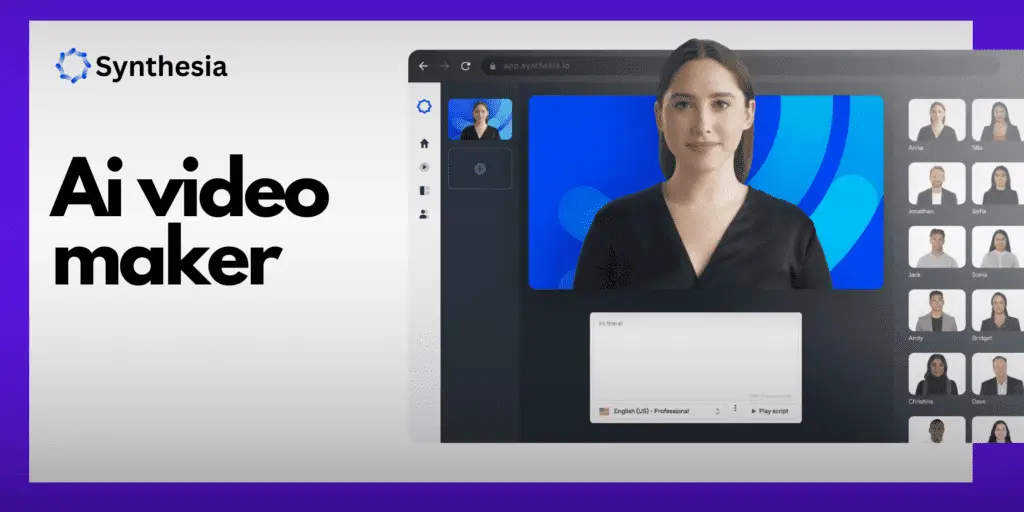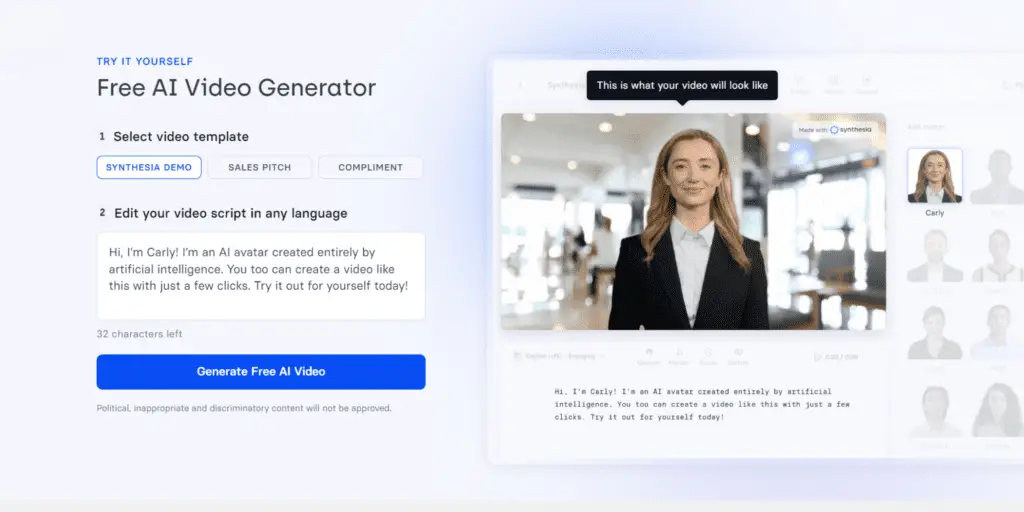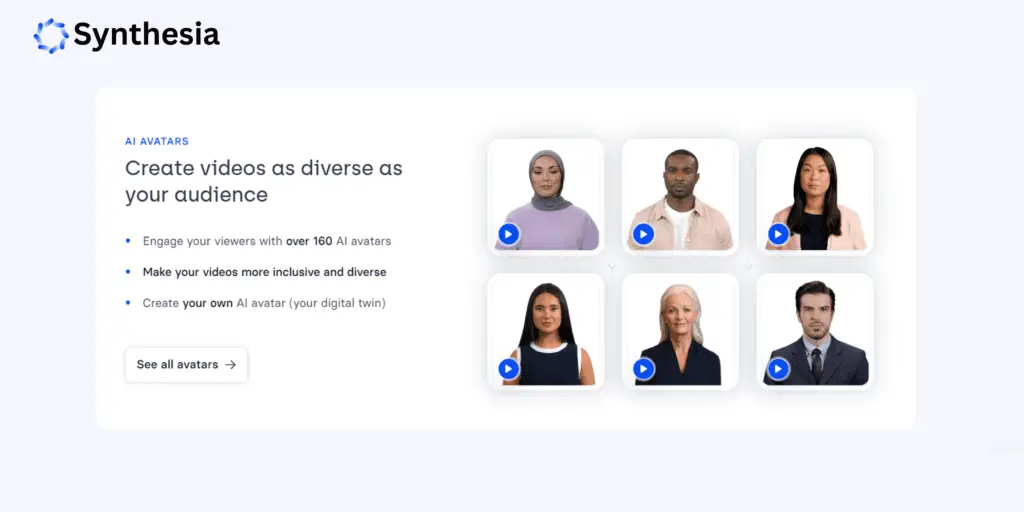Artificial intelligence and robotics, there exists a fascinating and somewhat eerie phenomenon known as the “uncanny valley.” This concept refers to people’s discomfort and eeriness when encountering a synthetic or artificial being that comes close to them but doesn’t quite achieve a lifelike appearance.
The journey out of this uncanny valley is challenging and fraught with the challenge of perfecting every minute detail that makes us uniquely human.
As we inch closer to this goal, several innovative companies are forging ahead, leveraging AI’s potential to create realistic human avatars for various practical applications.
Among the pioneers leading this charge is Synthesia, a company strategically focused on harnessing AI video technology for enterprise use cases.
Unlike consumer entertainment, which demands hyper-realism to fully engage its audience, enterprise applications such as employee onboarding and training videos offer a unique niche.
Synthesia’s approach to AI video generation is not just about bridging the gap between artificiality and realism but redefining how businesses create and distribute content.
With promises to streamline the video production process, Synthesia introduces a blend of innovation and practicality to the corporate world.
This exploration delves deep into Synthesia’s technology, its array of features, and the real-world applications that demonstrate its value and potential to transform video content creation across industries.
Understanding Synthesia AI
Synthesia AI emerges as a beacon of advancement, offering a sophisticated solution to the age-old challenges of video production. Synthesia is an AI-powered video generator at its core, but to merely describe it as such would be an understatement.
This platform is designed with a laser focus on enterprise and tech businesses, recognizing the extensive and often cumbersome process these entities face in maintaining a vast library of videos for training, onboarding, product demonstrations, and customer support.
The inception of Synthesia was motivated by a simple yet profound realization: traditional video production, involving actors, voiceovers, and a lengthy post-production process, is not only costly but also incredibly time-intensive.
This traditional method presents a barrier to timely updates and scalability, especially for dynamic businesses in the technology and enterprise sectors.
Synthesia’s solution is to leverage artificial intelligence to create lifelike avatars and generate videos that can be easily updated, translated, and personalized at a fraction of the cost and time.
Synthesia operates on a groundbreaking premise: why not replace human actors with AI avatars? This question led to the development of a platform where videos are generated using avatars that are astonishingly similar to humans in appearance and mannerisms.
These avatars are the product of a meticulous process. Over one hundred actors’ likenesses were captured by 160 cameras in a myriad of poses, expressions, and movements.
This vast dataset feeds into Synthesia’s neural video synthesis technology, creating avatars that can speak, gesture, and interact in nuanced and surprisingly lifelike ways. What sets Synthesia apart is its technological prowess and its strategic alignment with enterprise needs.
The platform is not chasing the dream of creating blockbuster movie-level CGI characters; instead, it aims to fill a critical gap in corporate communication, training, and marketing.
Doing so addresses a key challenge for businesses: keeping a significant and often global workforce informed, trained, and engaged without the logistical nightmares and costs associated with traditional video production.
This alignment with enterprise needs is evident in the platform’s design, offering features such as multilingual support, easy updates and edits, and a range of avatars representing workplace diversity.
It’s a testament to Synthesia’s understanding that efficiency, clarity, and relatability are paramount in the corporate world.

Technology Behind Synthesia
Synthesia’s groundbreaking service is at the heart of a sophisticated amalgamation of artificial intelligence, computer vision, and machine learning technologies, collectively driving the creation of realistic AI avatars and seamless video production.
This section unveils the technological wizardry that powers Synthesia and sets it apart in AI-driven video creation.
Creating a Synthesia avatar begins with an intricate process involving real actors and a sophisticated capture system.
Each avatar is based on a natural person whose likeness has been meticulously recorded using 160 cameras. These cameras capture a comprehensive array of movements, facial expressions, and vocal nuances, ensuring a rich dataset from which the AI can learn.
This extensive capture process is crucial for achieving natural movements and facial cues, laying the groundwork for avatars to convey emotions, engage viewers, and provide instructions or information with a human touch.
The diversity of actors and the breadth of captured data ensure that Synthesia’s avatars can be used in a wide range of video scenarios, representing different demographics and personalities.
Once the raw data is captured, Synthesia employs “neural video synthesis” to animate these avatars.
This technology uses deep learning algorithms to process the captured data, understand human expressions and movements, and replicate them in the AI avatars.
Neural video synthesis is at the forefront of AI technology. It enables Synthesia to produce videos in which avatars move, speak, and gesture in a manner that closely mimics real human behavior.
The process is both complex and computationally intensive, requiring the AI to learn from thousands of hours of video how to generate facial movements that match the spoken text and incorporate gestures and body language for a more natural presentation.
This capability makes the avatars more engaging and helps reduce the eeriness often associated with digital human representations, moving closer to overcoming the uncanny valley.
A standout feature of Synthesia’s technology is the ability to customize avatars in appearance and behavior.
Users can tailor gestures, expressions, and even the speaking style of their chosen avatar to fit the specific needs of their video project.
This level of customization is made possible by the underlying AI’s understanding of human nuances, enabling a tailored video experience that feels more personal and engaging.
Key Features of Synthesia
AI Video Avatars
- Utilizes over 100 real actors’ likenesses, captured using 160 cameras for natural movements and facial cues.
- Offers a library of 150+ diverse avatars, enabling customization for different scenarios and demographics.
- Includes improved “V3” avatars for enhanced realism, closely mimicking human behavior to reduce the uncanny valley effect.
- Allows for the creation of custom AI avatars and voice cloning, providing a personalized video experience.
Text-to-Speech Engine
- Supports over 120 languages and accents, catering to a global audience.
- Features a wide range of voice styles, from lifelike to professional, to match the video’s tone and purpose.
- Offers customizable pronunciation through the Diction feature, ensuring accurate delivery of specific terms or brand names.
- Includes the ability to adjust speech pacing and insert pauses, enhancing the natural flow of dialogue.
Presentation Design Tool
- User-friendly interface reminiscent of popular presentation software, facilitating ease of use.
- Provides over 65 video templates to jumpstart the video creation process.
- Features animations, a built-in screen recorder, and collaboration tools for a dynamic and interactive video presentation.
- Enables easy updates and edits to existing videos without the need for re-recording, saving time and resources.
Automation and Integration
- Offers integration with Zapier, allowing for automation of video creation, distribution, and management processes.
- Supports workflows with various applications, including Trello, Typeform, BambooHR, and YouTube, streamlining operations across tools.
Realistic Voice
- Advanced AI ensures lip-syncing matches the spoken dialogue, enhancing the believability of the avatars.
- Avatars can perform gestures and express emotions, further bridging the gap between AI-generated content and real human interaction.
Accessibility Features
- Automatically generates closed captions for videos, improving accessibility for viewers with hearing impairments.
- Offers a diverse range of avatar appearances and voices, ensuring inclusivity and representation in video content.
Real-World Application
Synthesia AI in real-world settings, the platform has demonstrated considerable promise, particularly in employee onboarding and training.
A hands-on project involving the creation of an onboarding presentation evaluated Synthesia’s capabilities. The process involved crafting a script, selecting an avatar complete with facial gestures, and opting for a voice accent that straddles the line between lifelike and professional.
The outcome was a compelling demonstration of Synthesia’s ability to streamline corporate training content production, offering a blend of engagement and efficiency. However, the experiment highlighted Synthesia’s limitations, notably in avatar realism and voice consistency.
While the avatars presented a significant degree of realism, challenges in achieving perfect lip synchronization were evident.
Similarly, the variability in voice quality—from highly realistic to somewhat robotic—underscores the importance of voice selection to match the video’s intended tone and audience.
The customization options within Synthesia, which allow for tailored gestures and expressions, stood out as a key strength. They enhance the platform’s appeal by enabling videos to connect more authentically with viewers.
This versatility extends to the ease of updating and editing content, which is particularly valuable for businesses aiming to maintain up-to-date training and communication materials without incurring recurrent production costs.
Synthesia’s application is not limited to training; it extends to internal communications, customer support, and marketing, as evidenced by its use by companies like Heineken to efficiently train a vast employee base.
Despite these advantages, Synthesia is not without its considerations. For high-stakes content, such as marketing and sales, where the human touch is paramount, the subtle nuances and emotional depth a real person brings might be preferable.
This is subtly acknowledged in Synthesia’s choice to use real people in some of its promotional materials, highlighting a strategic balance between leveraging AI-generated content and human-produced videos.
When juxtaposed with competitors like HeyGen, Synthesia’s focus on enterprise solutions becomes its defining edge, albeit with room for improvement in areas like lip-syncing and voice naturalness.
This comparative analysis not only situates Synthesia within the competitive landscape of AI video generation platforms but also delineates its most effective use cases and potential areas for enhancement.

The Future of AI Video Generation
The trajectory of AI video generation, epitomized by platforms like Synthesia, indicates a rapidly approaching future where synthetic media could largely supplant traditional video production methods.
As technology advances, the distinctions between AI-generated content and human-produced videos are becoming increasingly nuanced, with improvements in realism, versatility, and accessibility driving this evolution forward.
This shift heralds a transformative period for industries reliant on video content, promising significant impacts on efficiency, cost, and the scalability of video production.
AI avatars and text-to-speech technology, core components of platforms like Synthesia, are evolving at an impressive pace. Each iteration brings us closer to overcoming the uncanny valley. This phenomenon has long challenged the realm of synthetic human representations.
As these technologies mature, we can expect AI-generated videos to become indistinguishable from those featuring real humans in terms of visual and auditory presentation.
This progression is about enhancing realism and expanding the creative possibilities and applications of video content across sectors.
The implications for businesses are profound. With AI video generation, companies can produce high-quality video content at a fraction of the current costs and time.
This capability is advantageous for applications requiring frequent updates or localization in multiple languages, such as training materials, customer service videos, and global marketing campaigns.
The ability to generate accessible content with ease—such as automatically captioned videos—underscores the technology’s potential to make video content more inclusive.
The rise of synthetic media also prompts discussions about ethics, authenticity, and the role of human creativity in the digital age.
As AI-generated content becomes more prevalent, establishing guidelines and standards for its use will be crucial to address concerns around misinformation, copyright, and the representation of individuals.
In the not-too-distant future, we can anticipate a landscape where synthetic media facilitates a new era of content creation.
This doesn’t necessarily herald the obsolescence of traditional video production but instead introduces a complementary paradigm.
Real human experiences and creativity will continue to be invaluable. Still, AI will offer tools to augment and amplify our ability to tell stories, share information, and connect with audiences worldwide.
Synthesia’s prediction that “synthetic media will replace the need for physical cameras and complex video editing tasks” may soon become a reality, setting the stage for a revolution in how we conceive, produce, and consume video content.
As we stand on the brink of this new era, the fusion of AI innovation with human creativity promises to unlock unprecedented opportunities in video production, storytelling, and beyond.
Pricing and Getting Started
Synthesia AI positions itself as a formidable player in the AI video generation market, not only through its innovative technology and wide range of features but also through its accessible pricing model, which is designed to cater to various business needs.
Getting started is straightforward for those interested in leveraging this cutting-edge platform, with options designed to accommodate different scales of operation and budget constraints.
The Starter Plan, priced at $30 per month, is Synthesia’s entry-level offering. It allows users to generate up to 10 minutes of video content monthly.
This plan is ideal for small businesses or individual creators just beginning to explore the potential of AI-generated video content.
At $89 per month, the Creator Plan offers a more robust solution, providing up to 30 minutes of video generation time monthly. This plan suits medium-sized businesses or content creators who need more video content but are still mindful of budget constraints.
For larger enterprises with more extensive content creation needs, Synthesia offers customized solutions. Pricing for corporate packages varies based on specific requirements, including video generation time, the number of users, and additional features tailored to the organization’s needs.
Synthesia encourages users to test its capabilities by offering the ability to generate a test video for free.
This trial allows prospective users to explore the platform’s user interface, experiment with different avatars and voices, and gauge the quality of the output before committing to a subscription.
Once satisfied with the trial, users can sign up for one of the paid plans via Synthesia’s website. The sign-up process is straightforward and requires only basic information and payment details.

Final Thoughts
As we delve into Synthesia AI’s capabilities and applications for video generation, it becomes evident that we are standing at the cusp of a transformative era in content creation.
Synthesia, with its innovative use of AI avatars, neural video synthesis, and user-friendly features, is not just a tool but a harbinger of the future of video production.
Its ability to democratize video creation, making it accessible, efficient, and affordable, promises to reshape how businesses and individuals communicate, educate, and market.
Exploring Synthesia’s features, from the creation of realistic AI avatars to the seamless integration of text-to-speech technology and presentation design tools, showcases the platform’s commitment to breaking down barriers in video production.
The inclusion of automation and integration capabilities further emphasizes its versatility and power as a tool for a wide range of applications, from corporate training and marketing to personalized customer engagement.
As with any frontier technology, the journey is as much about navigating challenges as it is about embracing opportunities.
The evolution of Synthesia and similar platforms must consider ethical considerations, the importance of human touch in storytelling, and the potential for misinformation.
As synthetic media becomes more indistinguishable from reality, the dialogue around these issues will become increasingly critical.
The future of AI video generation is bright, with Synthesia at the forefront of this innovation. The platform’s ability to evolve and adapt to the changing landscape of video production will be critical to its continued success.
For businesses and content creators ready to embark on this journey, Synthesia offers a gateway to unlocking creative potentials and achieving efficiencies previously unimaginable.
Synthesia AI represents not just a technological achievement but a shift in the paradigm of video content creation.
It embodies AI’s potential to augment human creativity, offering a glimpse into a future where anyone can bring their ideas to life through video without the constraints of traditional production processes.
As we move forward, the integration of AI in video production, exemplified by Synthesia, will undoubtedly play a pivotal role in shaping tomorrow’s narratives and experiences.


